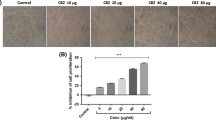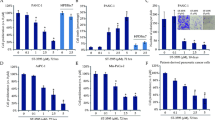Abstract
We studied the effects of suberoylanilide hydroxamic acid (SAHA), a histone deacetylase (HDAC) inhibitor, on colon cancer. The expression of HDACs in colorectal cancer specimens and the effects of SAHA on colon cancer cells and tumors of nude mice were assessed. Treatment with SAHA (3 μm) for 72 h induced downregulation of different subtypes of HDAC proteins and also induced acetylation of histone 3 and histone 4. SAHA significantly inhibited the expression of the oncogenic protein c-myc and also increased the expression of the p53 and Rb proteins. The immunohistochemical staining of HDACs, including HDAC1, HDAC2, HDAC3, and HDAC4, was significantly increased in colorectal adenocarcinoma specimens compared to healthy control tissues. In addition, murine studies showed that 100 mg/kg SAHA administered by intraperitoneal injection significantly induced tumor necrosis and inhibited the growth of colon tumors. Immunohistochemistry of the tumor tissues from nude mice revealed that SAHA inhibited the expression of different subtypes of histone deacetylase, the anti-apoptotic proteins cyclin D1, survivin, and also inhibited cell proliferative as determined by Ki67 expression. SAHA inhibited the growth of colon tumors by decreasing histone deacetylases and the expression of cyclin D1 and survivin in nude mice.






Similar content being viewed by others
References
Mayer RJ (2009) Targeted therapy for advanced colorectal cancer-more is not always better. N Eng J Med 360:623–625
Wilko W, Annika R, Silvia N, Aurelia N, Ann-Christin B, Manfred D, Volker G, Boehm M, Thomas B, Carsten D (2008) Class I histone deacetylase expression has independent prognostic impact in human colorectal cancer: specific role of class I histone deacetylases in vitro and in vivo. Clin Cancer Res 14:1669–1677
Ito K, Adcock IM (2002) Histone acetylation and histone deacetylation. Mol Biotechnol 20:99–106
Kuo MH, Allis CD (1998) Roles of histone acetyltransferases and deacetylases in gene regulation. Bioessays 20:615–626
Kim DH, Kim M, Kwon HJ (2003) Histone deacetylase in carcinogenesis and its inhibitors as anti-cancer agents. J Biochem Mol Biol 36:110–119
Marks PA, Richon VM, Breslow R, Rifkind RA (2001) Histone deacetylase inhibitors as new cancer drugs. Curr Opin Oncol 13:477–483
Luong QT, O’Kelly J, Braunstein GD, Hershman JM, Koeffler HP (2006) Antitumor activity of suberoylanilide hydroxamic acid against thyroid cancer cell lines in vitro and in vivo. Clin Cancer Res 12:5570–5577
Sun PC, Tzao C, Chen BH, Liu CW, Yu CP, Jin JS (2010) Suberoylanilide hydroxamic acid induces apoptosis and sub-G1 arrest of 320 HSR colon cancer cells. J Biochem Sci 17:76–85
Jin JS, Hsieh DS, Loh SH, Chen A, Yao CW, Yen CY (2006) Increasing expression of serine protease matriptase in ovary tumors: tissue microarray analysis of immunostaining score with clinicopathological parameters. Mod Pathol 19:447–452
Jin JS, Wu WY, Lin YF (2006) Higher expression of epidermal growth factor receptor is associated with extracellular matrix metalloprotease inducer in colorectal adenocarcinoma: tissue microarray analysis of immunostaining score with clinicopathological parameters. Dis Markers 22:309–316
Jung M (2001) Inhibitors of histone deacetylase as new anticancer agents. Curr Med Chem 8:1505–1511
Lindemann RK, Gabrielli B, Johnstone RW (2004) Histone-deacetylase inhibitors for the treatment of cancer. Cell Cycle 3:779–788
Truchet I, Jozan S, Baron S (2008) Estrogen and antiestrogen-dependent regulation of breast cancer cell proliferation in multicellular spheroids: Influence of cell microenvironment. Int J Oncol 32:1033–1039
Minucci S, Pelicci PG (2006) Histone deacetylase inhibitors and the promise of epigenetic (and more) treatments for cancer. Nat Rev Cancer 6:38–51
Alessandro V, Cinzia V, Gessica F, Elena CC, Mirko B, Debora R, Prasun C, Chantal P, Raffaele DF, Paola G, Christian S, Stefania DM (2004) Crystal structure of a eukaryotic zinc-dependent histone deacetylase, human HDAC8, complexed with a hydroxamic acid inhibitor. PNAS 101:15064–15069
Wang S, Yan-Neale Y, Cai R, Alimov I, Cohen D (2006) Activation of mitochondrial pathway is crucial for tumor selective induction of apoptosis by LAQ824. Cell Cycle 5:1662–1668
Zbar AP, Kennedy PJ, Singh V (2009) Functional outcome following restorative rectal cancer surgery. Acta Chir Iugosl 56:9–16
Kelly WK, O’Connor OA, Krug LM (2005) Phase I study of an oral histone deacetylase inhibitor, suberoylanilide hydroxamic acid, in patients with advanced cancer. J Clin Oncol 23:3923–3931
Sakajiri S, Kumagai T, Kawamata N, Saitoh T, Said JW, Koeffler HP (2005) Histone deacetylase inhibitors profoundly decrease proliferation of human lymphoid cancer cell lines. Exp Hematol 33:53–61
Bali P, Pranpat M, Swaby R (2005) Activity of suberoylanilide hydroxamic acid against human breast cancer cells with amplification of Her-2. Clin Cancer Res 11:6382–6389
Rundall BK, Denlinger CE, Jones DR (2005) Suberoylanilide hydroxamic acid combined with gemcitabine enhances apoptosis in non-small cell lung cancer. Surgery 138:360–367
Takai N, Desmond JC, Kumagai T (2004) Histone deacetylase inhibitors have a profound antigrowth activity in endometrial cancer cells. Clin Cancer Res 10:1141–1149
Takai N, Kawamata N, Gui D, Said JW, Miyakawa I, Koeffler HP (2004) Human ovarian carcinoma cells: histone deacetylase inhibitors exhibit antiproliferative activity and potently induce apoptosis. Cancer 101:2760–2770
Altieri DC (2006) The case for survivin as a regulator of microtubule dynamics and cell-death decisions. Curr Opin Cell Biol 18:609–615
Noh EJ, Lim DS, Jeong G, Lee JS (2009) An HDAC inhibitor, trichostatin A, induces a delay at G2/M transition, slippage of spindle checkpoint, and cell death in a transcription-dependent manner. Biochem Biophys Res Commun 378:326–331
Kim DH, Kundu JK, Surh YJ (2011) Redox modulation of p53: mechanisms and functional significance. Mol Carcinog 50:222–234
Shen F, Kirmani KZ, Xiao Z, Thirlby BH, Hickey RJ, Malkas LH (2011) Nuclear protein isoforms: implications for cancer diagnosis and therapy. J Cell Biochem 112:756–760
Smith RA, Tang J, Tudur-Smith C, Neoptolemos JP, Ghaneh P (2011) Meta-analysis of immunohistochemical prognostic markers in resected pancreatic cancer. Br J Cancer 104:1440–1451
Acknowledgments
This study was supported by a grant from the Tri-Service General Hospital (TSGH-C100-007-009-10-S04), R. O. C.
Declaration of competing interests
The authors declare that they have no competing interests.
Author information
Authors and Affiliations
Corresponding author
Rights and permissions
About this article
Cite this article
Jin, JS., Tsao, TY., Sun, PC. et al. SAHA Inhibits the Growth of Colon Tumors by Decreasing Histone Deacetylase and the Expression of Cyclin D1 and Survivin. Pathol. Oncol. Res. 18, 713–720 (2012). https://doi.org/10.1007/s12253-012-9499-7
Received:
Accepted:
Published:
Issue Date:
DOI: https://doi.org/10.1007/s12253-012-9499-7




